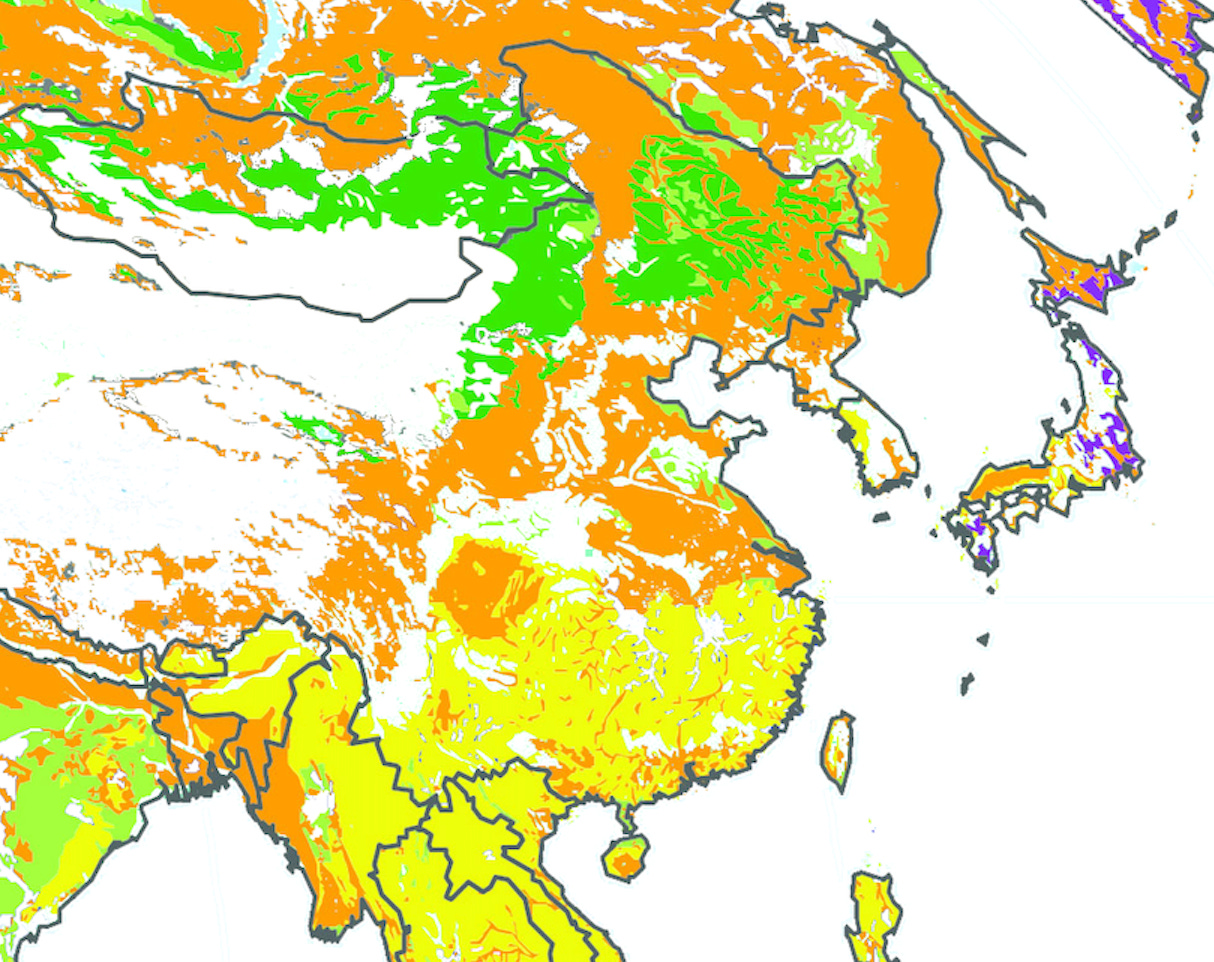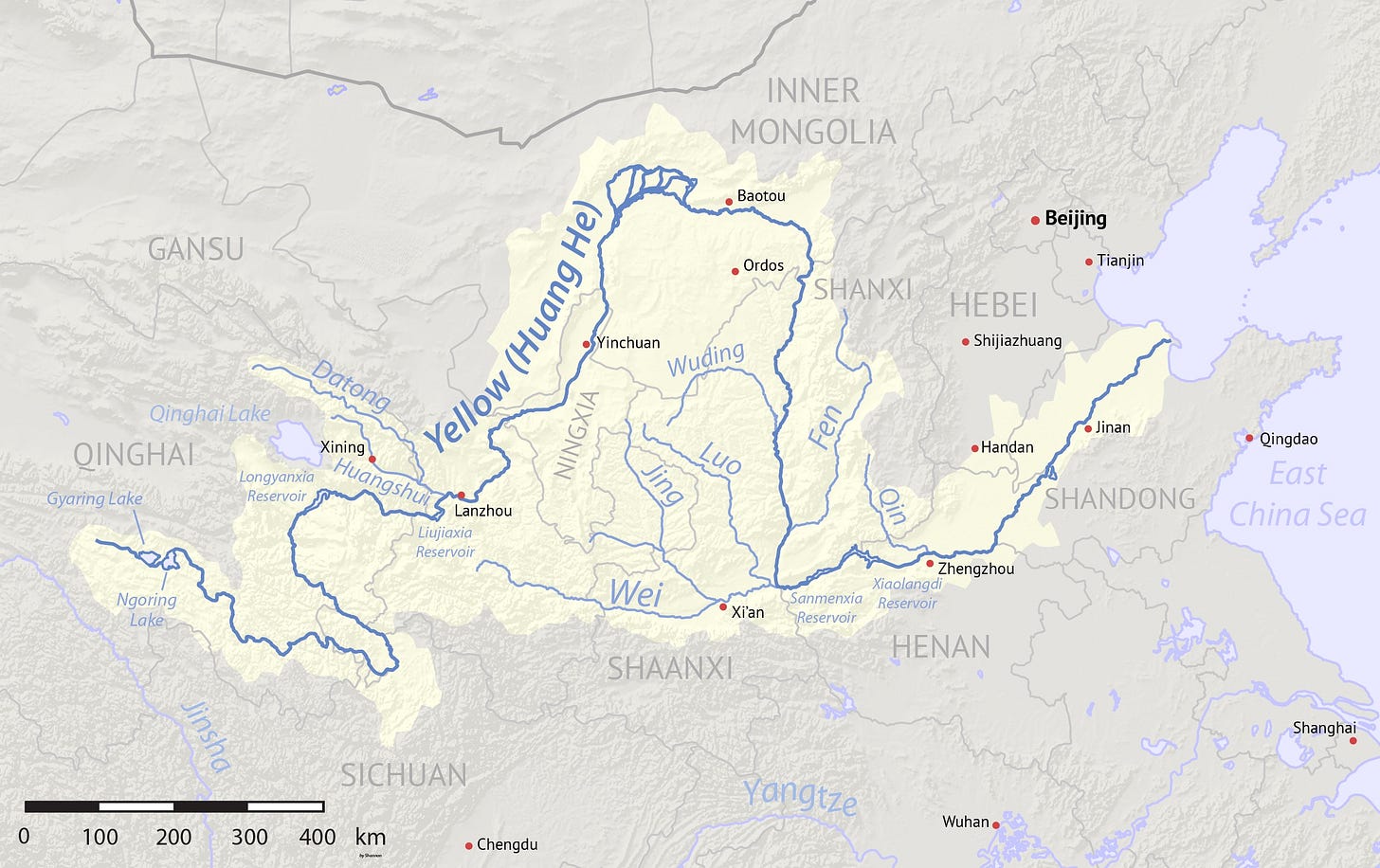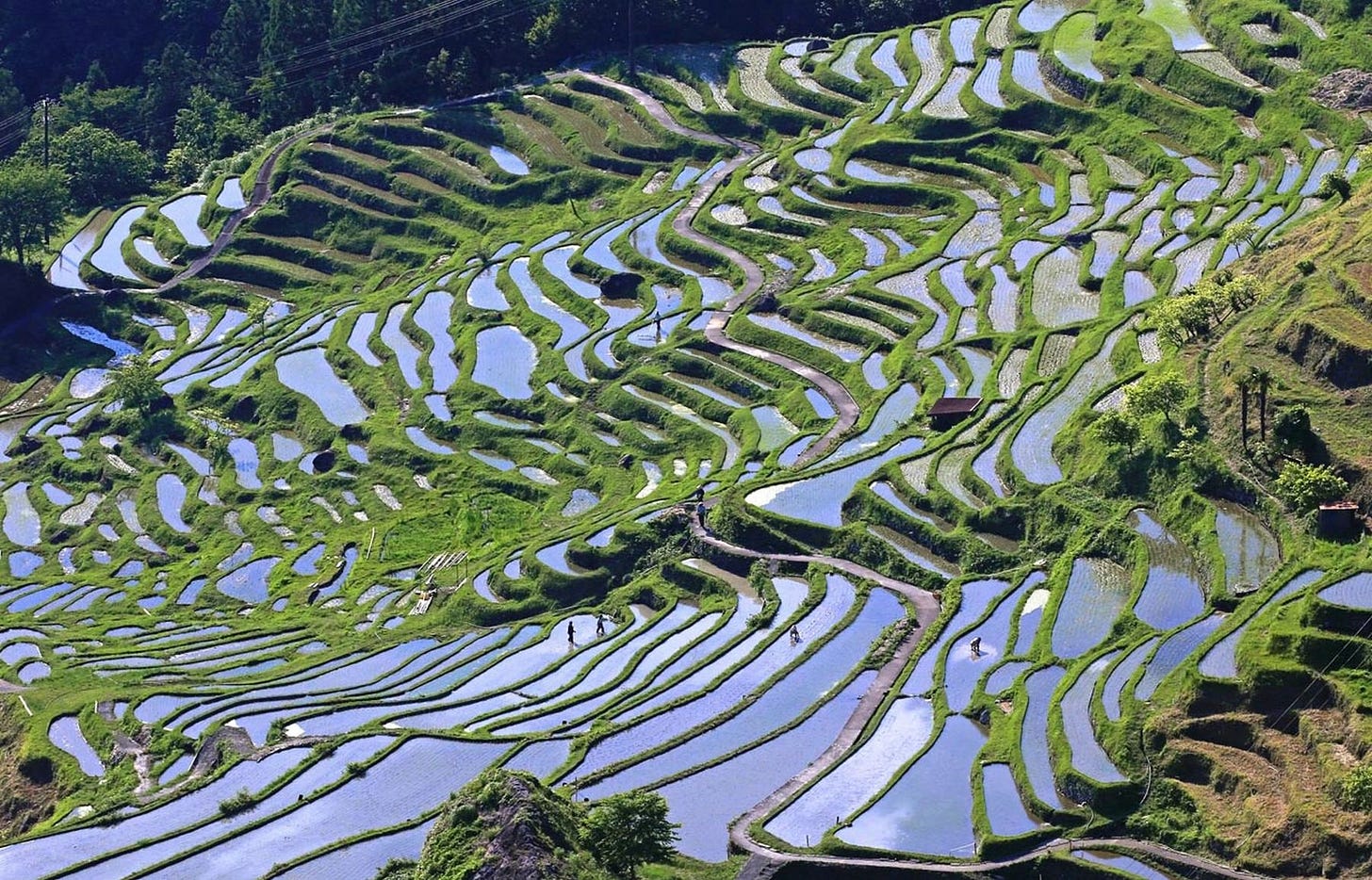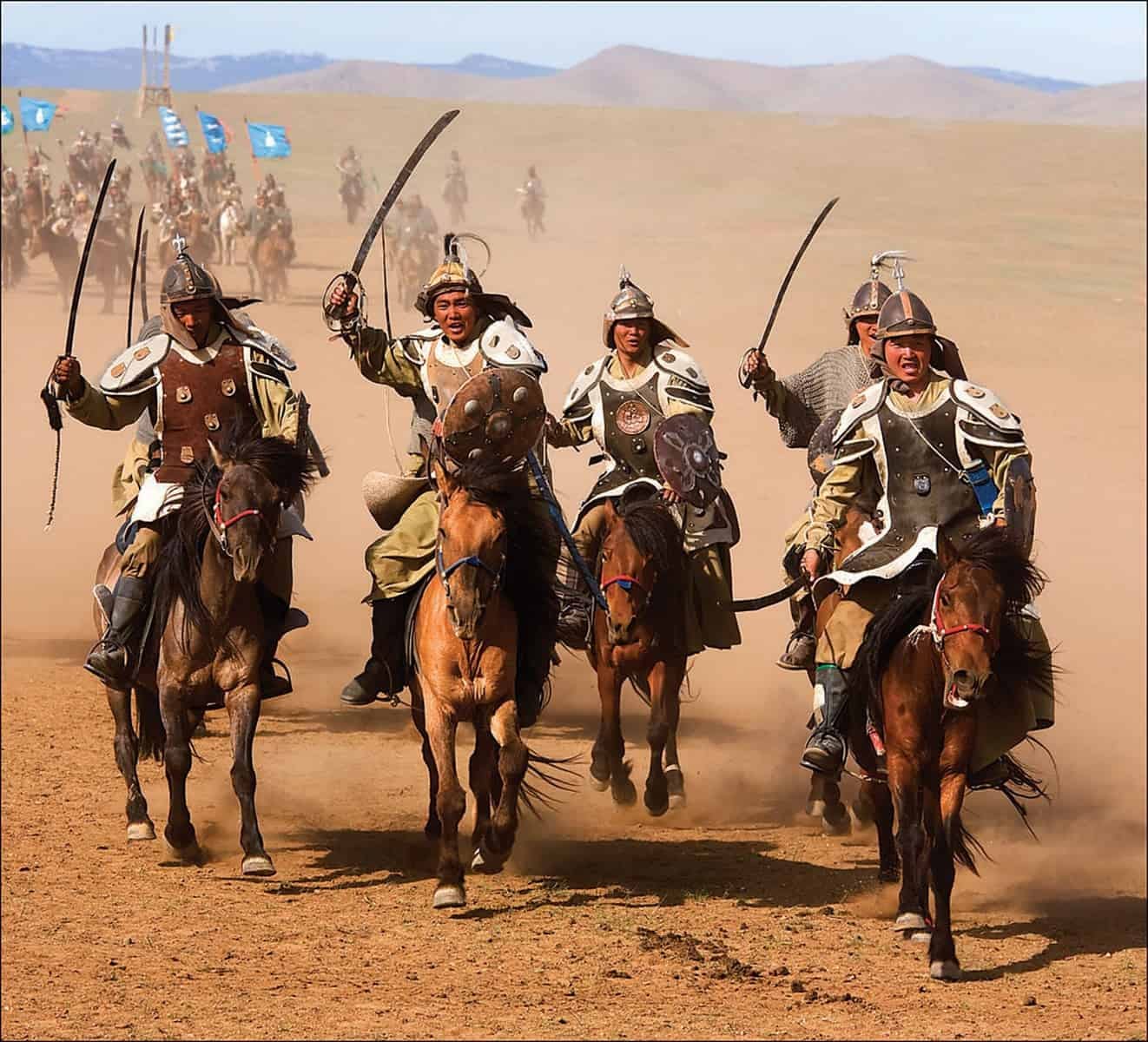How geography shaped East Asian history
And made China one of the most dominant civilizations in world history.
A major focus of my book series and this Substack column is the geographical foundations of human material progress. In particular, I am interested in geographical factors that enabled complex societies to evolve.
By complex societies, I mean:
Agrarian societies (who acquired their food calories from plow-based agriculture)
Commercial societies (who invented progress)
Industrial societies (which most of us live in today)
First of all, let me be clear.
Geography does not create human material progress. Geography is a constraint on human material progress, but some regions have fewer constraints than others. Those lucky regions were able to develop far more complex societies than the rest of the world. Eventually, this led to a significantly higher material standard of living for the masses.
The critical historical sequence of Society Types that we are looking for is:
Hunter-Gatherer society (which is the starting point of every region) >
Horticultural society (agriculture with hand tools) >
Agrarian society (agriculture with animal-traction plows) >
Commercial society, which invented material progress >
Industrial Revolution, which expanded existing material progress.
Geography plays a massive constraint on each of these stages, so most regions have a hard cap on the level of complexity of human societies that can evolve without assistance from outside.
The Industrial Revolution and the American-backed global free trade order established after World War II made this assistance possible.
In this series how geography has influenced economic development by region, I define regions by natural geographic borders, not modern political borders. In this article, I will focus on one region that had fewer geographical constraints than most other all other regions: East Asia. By East Asia, I mean Japan, Korea and the North China Plain, but it excludes the Deserts and Highlands of western China and the Tropical Forests of Southern China. Other than the Middle East, East Asia developed agriculture and Agrarian societies earlier than any other region. Unlike the Middle East and other regions, East Asia has been dominated by one society: China.
Much of this post is an excerpt from my book From Poverty to Progress: Understanding Humanity’s Greatest Achievement. You can order my e-books and audiobooks at a discounted price at my website, or you can purchase full-price ebooks, audiobooks, paperback, or hardcovers on Amazon.
Other books in my “From Poverty to Progress” book series:
Other articles about how geography has influenced economic development by region:
Why are there such huge variations in income across the globe?
How geography constrained progress (intro to this series)
Biomes
The single most important factor in whether a region enables complex societies to evolve is its biome. A biome is a category for a geographical area based on its dominant vegetation. The dominant vegetation in any area sets very broad constraints on what type of plants and animals can evolve there. The dominant vegetation sustains the local herbivores, which then sustain the local carnivores. Since humans use a portion of these plants and animals as base materials for food production, biomes play a critical role in constraining the types of human societies that can develop within them.
Plow-based agriculture, a necessary transition step to modern progress, is only possible at a distance from river basins in a few biomes:
Temperate Forest biomes
Mediterranean biomes
(after the invention of the steel plow in the 1830s) Temperate Grassland biomes.
East Asia is dominated by one of the largest expanses of Temperate Forest biome in the world. This gave the region vast tracts of land that could potentially be used for agriculture. Only Europe and North America are anywhere near it in size. If you want one simple reason why East Asia evolved into influential civilizations, this is it. This one simple fact virtually ensured that agricultural societies would evolve in the region.
The powerhouses of the Temperate Forest biome are the leaves on deciduous trees, most of which are species of beech, walnut, ash, maple or birch. While needles on conifers and leaves in tropical latitudes stay on the tree year-round, most deciduous trees in temperate latitudes go through a seasonal cycle of losing their leaves in the autumn and then regrowing them in the spring.
Losing leaves in the autumn protect the branches from cold, dry winters; growing them back in the spring enables trees to deploy what are effectively organic solar panels. Leaves are typically very thin and wide, giving the tree a huge amount of surface area for catching sunshine for photosynthesis. While the trees have evolved this behavior for their survival, the benefits to the rest of the ecosystem are impressive.
Leaves are packed full of sugars and other nutrients, perfect for consumption by insects and browsing mammals. When nitrogen-rich leaves fall to the ground in the autumn and then unfreeze in late winter and early spring, they create a thick layer of hummus on top of the soil. Spring rains wash the nutrients deeper into the soil, where huge numbers of decomposing bacteria and animals ensure these nutrients nourish the deepest layers of soil. The thick hummus also provides a perfect habitat for earthworms and burrowing mammals, which aerate the soil.
During the winter, the trees and many animals in Temperate Forests go into dormancy. Birds usually migrate to warmer climates. The next spring when the snow and ice melt, those nutrients from the leaves are then gathered by plant roots from the soil and redirected into growing new leaves.
Because fresh young leaves contain the most nutrients, spring in Temperate Forest biomes is an explosion of life. Insect larvae hatch to take advantage of this bounty, luring in migratory birds for the feast. Browsing mammals give birth to babies for the same reason. This constant seasonal cycle ensures that Temperate Forests have some of the most productive soils in the world.
In addition, trees themselves give humans one of the most useful materials in the world: wood. Wood can be used for heating during the night and winter, a necessity in colder temperatures. Wood is also one of the most useful materials for the construction of tools, dwellings and transportation devices. Wood can also be used to make charcoal, a crucial first step in metalworking technology.
Humans gradually learned how to use wood, rain and fertile soil to create productive agricultural systems capable of generating a food surplus. This food surplus enabled dense human populations that promote innovation and progress. Countries situated in the Temperate Forest biome include China, Japan, Korea, USA, UK, Netherlands, France, Germany, Russia and Northern Italy. Citizens from societies inhabiting the Temperate Forest biome have recorded the bulk of written human history.
The one key disadvantage of the Temperate Forest biome is the relative lack of native wild ancestors of domesticable plants and animals. Virtually all such species in use today arrived via human migration from other biomes.
Soil
Even with the proper biomes, a region needs fertile soil for agriculture. Because agriculture is key to feeding dense human populations, the type of soil in a region is critical to its ability to support complex societies. Soil is the combination of:
weathered rock,
air,
water, and
organic matter from decomposing plants and animals.
East Asia (particularly Northeast China) is dominated by Inceptisol soil, which is agriculturally productive. Korea and Japan were less fortunate with their soil, although Korea has a section of Ultisol soil near present-day Seoul. And Japan had sections of Inceptisols and Andosols (from volcanic activity), particularly in Southern Honshu and the Osaka/Tokyo region. Manchuria and Inner Mongolia have substantial amounts of extremely productive Mollisol soils, but these were very hard to exploit until the invention of the steel plow in the 19th Century.
Notice that Southeast China and Indochina are dominated by Ultisol soils. These soils are less productive as they have experienced hundreds of millions of years of weathering and depletion (likely because of their Tropical Forests).
It should not be at all surprising that agriculture in East Asia originated in Northern China (where soil is most productive) and then gradually migrated south to less fertile soils. Note also that the expanses of productive soil are much less in Japan and the Korean peninsula. This almost guaranteed that the China would become far more populous than the other East Asian regions. This far larger population laid the foundation for China’s far greater political, military, and cultural significance.
Rivers
Most large and prosperous cities are located on rivers or natural ocean ports. Rivers offer crucial advantages to human development. Rivers:
Offer sources of (hopefully) clean drinking water.
Make it easier to remove human waste.
Offer sources of irrigation for crops.
Deposit additional nutrients in the soil for growing crops.
Enable cost-effective transportation of people and freight.
Offer defensible lines to block the approach of enemy armies.
East Asia is dominated by three major rivers:
The Yellow river (Huang He) in northern China, which is the second-longest river in China and the sixth-longest in the world. More importantly, it was where Chinese civilization was founded.
The Yangtze river, which is the longest river in Eurasia and the third-longest in the world. The river is the site of many of China’s largest cities, including Shanghai, Nanjing, Wuhan, and Chongqing. All of these cities have played significant roles in Chinese history.
The Pearl river, which played a lesser historical role compared to its bigger brothers listed above. Today, however, the Pearl river basin punches way above its weight class as the economic powerhouses of Hong Kong, Macau, and Guangzhou all sit on or very near its mouth. Indeed, this region is now the most populated urban area in the world with nine different mega cities and over 10% of Chinese GDP.
If you know nothing about East Asia other than its biome, soil type, and rivers, then you know enough to understand why China became a regional powerhouse. It is difficult to see how it could have done otherwise. The key historical contingency was whether the three river basins would be united under one kingdom (which they did) or they would evolve into three separate kingdoms warring against each other (which they often did during periods of civil war).
In addition, the Chinese built a complex system of canals to connect the major rivers to each other. The most famous was the Grand Canal, which links the Yellow and Yangtze river to its modern capital: Beijing.
Japan and Korea have no major navigable rivers, so they were forced to use the ocean as their primary means of water transportation.
One important point is that rice farming in irrigated waters is an excellent substitute for less productive soil. I plan on writing an entire article on this topic, so I will not go into detail here, but rice paddies store their nutrients in the water, not in the soil (as virtually every other type of farming does).
Essentially, monsoon rains in the Himalayas erode essential nutrients from the mountains and rivers carry those nutrients to the plains. Farmers then build canals and paddies to deposit the nutrient-laden river water into their rice fields. With each monsoon season, nutrients replenish the soil and keep the soil from becoming infertile.
Altitude
Except for Highlands in Tropical latitudes, complex societies are concentrated on the plains at altitudes of 500 meters or lower. While landmass on Earth varies in altitude from just below sea level to 10,000 meters above, about 73.7 percent of humanity inhabits altitudes of less than 500 meters above sea level.
Eastern China has vast expanses of land below 500 meters in altitude, while the rest of China, Korea, and Japan are quite mountainous. Mountains over 500 meters high dominate the Korean peninsula, although the western coast has sizeable plains. Japan is even more dominated by mountains, but there is a small plain in the Osaka/Tokyo region.
This meant that the Chinese population was far less constrained than Korea or Japanese. In Japan and Korea, cities are relatively isolated from each other by oceans and mountains. In China, they are connected to each other via rivers, canals, and plains.
Growing Season
Even if a region has a desirable biome, low altitude, and agriculturally productive soil types, other factors can preclude the development of productive agriculture. Even in areas that have all the necessary factors, some days are too hot; some days are too cold; some days have too much rain and other days have too little rain. One or two days of any of the above are not a problem, but if those days are strung together for weeks or months, agricultural production is seriously constrained.
Korea, Japan and Southeast China are blessed with very long Growing Seasons. Note this in one of the few geographical advantages that Southeast China has over Northeast Asia. As one moves northward, the Growing Season diminishes rapidly once you pass the Yangtze river basin. My guess is that this was a major reason why the Chinese people migrated southward despite inferior soils.
Wild ancestors of domesticated animals and plants
Most of the factors that enable productive agriculture are pure geography, but biogeography also plays an important role. Productive agriculture requires domesticated animals and domesticated plants. In particular, a region needs:
Animals that provide a reliable source of protein and fatty acids: cows, pigs, goats, sheep, or chickens.
Animals that are capable of pulling plows: horses, cows, or water buffalo
Staple crops that provide dense sources of carbohydrates, such as rice, wheat, corn, or potatoes.
Before a society can domesticate a plant or animal, the wild ancestors of those plants and animals need to be either:
located in the region or
close enough that human migration can bring those domesticated animals into the region.
Just as we saw with Europe, East Asia has a major disadvantage in lacking the wild ancestors of domesticated plants and animals. If Europe and East Asia was isolated from the rest of the world (like, for example, Australia), this might have prevented the two regions to evolve into Horticultural or Agrarian societies.
More on that later.
The threat of Herding societies
Now we come to a huge geographical disadvantage that has tormented the Chinese people for millennia (and to a lesser extent the Koreans and Japanese): geographical proximity to steppe Herding societies. One of the most enduring themes of Chinese history was the life-and-death struggle between the herding warriors of modern-day Mongolia and the farmers of modern-day China.
Chinese history is littered with dynasties established by Central Asians. The Xianbei, Di, Xiongnu, Jie, Qiang, Dingling, Sogdian, Gokturk, Shatuo, Khitan, Baiman, Tangut, Jurchen, Mongol, and Manchu are all examples of non-Chinese people who ruled all or parts of China for a significant period. The vast majority of these people lived in Herding societies from the steppe.
As Peter Turchin has argued (summary here on my online library of book summaries), until the widespread use of firearms and cannons, the horse archers of the Eurasian steppe were the dominant military threat to Agrarian societies.
Agrarian societies that were located near Temperate Grassland biomes in Eurasia with horse archers faced an existential threat. Combining rapid strategic and tactical mobility with standoff weapons in the form of the composite bow-and-arrow, the Herding societies of the steppe were dangerous enemies.
In the period between 400 and 1500, these peoples formed expansive empires that dominated the Agrarian societies of China, Korea, India, Persia, Russia, and the Middle East. While these empires were often short-lived and led to few long-term changes, they did have a devastating impact on the lands that they conquered.
Despite their ability to dominate Agrarian societies, it is doubtful whether Herding societies were able to deliver progress to their people in the long term. Undoubtedly, the conquest of richer Agrarian societies enabled them to extract greater resources from farmers, but most of these empires were fleeting in duration.
More importantly, these Herding empires were parasitic in nature. Rather than creating wealth, they extracted wealth from Agrarian societies through military conquest. Once Herding societies lost their military dominance because of the invention of firearms, their people returned to their poorer Herding lifestyle.
A large number of Central Asian tribes conquered and ruled China for a significant portion of Chinese history. Many “Chinese dynasties” were actually dominated by non-Chinese conquerors from the North. Throughout Chinese history, the threat from the Central Asian tribes was the primary military threat.
I believe the constant military threat of from the Central Asian tribes played a major role in inhibiting Chinese economic growth and had a lesser impact on Korean and Japanese.
Geographical Isolation
Societies often develop by copying technologies, skills, and social organizations from other societies. And military conquest by other societies can seriously set back long-term development. Because of these two facts, neighboring societies have a major impact on societal development.
The most important such constraint was proximity to the Middle East. As we have seen, agriculture evolved in the Fertile Crescent (modern-day Syria, Iraq, and Southern Turkey). Early Agrarian societies in Egypt, Mesopotamia, and Anatolia played an important role early in the Agrarian era. These regions played a critical role because they had many wild ancestors of domesticated plants and animals.
The exact origins of Chinese domesticated grains and animals are still a matter of great dispute. It seems likely that the Chinese “invented” its own domesticated grains and animals, but at the very least, a substantial portion of domesticated animals came from the Middle East and Central Asia. The fact that East Asia was connected to those regions via a massive continent surely assisted the regions’ economic development. This is in stark contrast to agricultural systems that evolved in North America, South America, New Guinea, and Africa.
So what are we to make of all this?
For all of the reasons listed above, it should not be a surprise that East Asia saw the evolution of complex Agrarian societies throughout the region. East Asia possessed one of the largest geographical areas capable of supporting the Agrarian sequence. In particular, the North China Plain has played a critical role in world history. Not surprisingly Hunter-Gatherer and Fishing societies were pushed aside by the far more powerful Agrarian societies.
I think that given all the geographical characteristics of East Asia, it was extremely likely that the region would evolve into:
Hunter-Gatherer society (which is the starting point of every region) >
Horticultural society (agriculture with hand tools) >
Agrarian society (agriculture with animal-traction plows) >
Given the vast expanses of Temperate Forest biomes on plains below 500m altitude with productive soil and navigable rivers, it seems almost inevitable that very powerful Agrarian regimes would evolve in modern-day China. The key question is whether they would evolve into one, two, or three separate kingdoms sited on the major navigable rivers. I think that all three of those options were possible.
But could Commercial societies evolve in the region? Almost all the geographical preconditions of Commercial societies were present. What was missing was:
Defensible borders
Political decentralization that would have given cities political autonomy.
All major Chinese cities had very serious problems defending themselves. They were at constant threat from powerful Emperors and terrifying steppe warriors. And the richer a city got, the more tempting a target for plunder they would become. I will not say that this made Commercial societies impossible, but they made them unlikely.
Chinese history meandered back and forth between powerful centralized empires and local control during periods of civil war between dynasties. A strong Commercial society might have evolved during those periods of civil war, but it would likely have been a temporary state.
More promising is Japan. Japan had a lengthy period of decentralized political development that strongly resembled European feudalism. The mountainous terrain effectively cut off Japanese cities from each other. A maritime-based Japanese commercial city might have evolved and grown strong enough to fend off raiding by samurai. Nagasaki, an ocean port on a defensible peninsula on the southern tip of the Japanese archipelago, seems a prime candidate. But this never really happened.
So no region in East Asia was never able to make the critical transition from an Agrarian regime to a Commercial society, similar to:
Medieval city/states of Northern Italy (Venice, Florence, Genoa, Milan, and many more)
Late Medieval city/states of Flanders (Ghent, Bruges, Ypres, and Antwerp in modern-day Belgium)
The Dutch Republic (1579-1795)
Pre-industrial England, particularly in the southeast (roughly 1500-1800)
Likely also many of the city/states of Ancient Greece.
This left East Asia mired in poverty for the masses until Japan made the jump into an Industrial society starting in the 1870s.
But that is for a different article.
Much of this post is an excerpt from my book From Poverty to Progress: Understanding Humanity’s Greatest Achievement. You can order my e-books and audiobooks at a discounted price at my website, or you can purchase full-price ebooks, audiobooks, paperback, or hardcovers on Amazon.
Other books in my “From Poverty to Progress” book series:
Other articles about how geography has influenced economic development by region:
Why are there such huge variations in income across the globe?
How geography constrained progress (intro to this series)
Some other great Substack columns on geography that you should subscribe to:
























From the Song dynasty onward, I would argue that commercialization steadily grew with each successive dynasty. However, the later stages of these dynasties were often characterized by persistent political and economic struggles within the imperial courts, which gradually eroded their authority. This dual dynamic had both positive and negative effects on the development of a commercial society: while it loosened some of the restrictive controls imposed by the state, it also introduced instability that disrupted markets across much of China.
Moreover, certain regions, particularly along the southeastern coast, developed economic systems in which commercial power arguably eclipsed agrarianism in influence. The extent to which these commercial forces could be regulated or restrained often depended on the strength and reach of imperial authority at the time.
I believe China possessed significant potential to transition into a commercial and industrial society, second only to Europe. Given a few more dynastic cycles, this transition might well have been realized. Evidence of this potential is evident in British accounts of their leased ports during the late Qing dynasty. Many of these ports demonstrated an almost immediate capacity to shift toward commercial and industrial development, as many of the necessary foundational conditions were already in place.
A great summary. Thanks.
I suppose the analogy can be extended too far, but the three rivers of China have a somewhat similar look to the Loire-Rhine-Danube complex in Europe. I had not appreciated how the rivers in China were "so close and yet so far from each other".
Would it be fair to say that the social structures and norms desired or required to manage and control major irrigation systems and related agricultural output, storage, distribution, etc., creates a more closely joined situation compared to Mongol or other pastoral raiding societies? And that those kinds of societies tend to have a greater trust factor among "strangers", a situation also desired to evolve towards commercial activities?
This also suggests that there are another 3 or 4 factors that should be added to the set required for a space traveling technological society to develop on some star systems/ planets rather than on others. Besides the "Goldilocks" 3rd planet from the Sun kind of situation, said planet needs some of your factors as well? Further lowers the probability of other space based somethings developing out there.
"Take me to your river basins!"